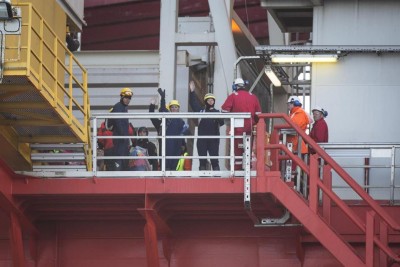UPDATED: Norwegian police moved in early Thursday to remove Greenpeace activists who had illegally boarded a Statoil-chartered offshore drilling rig in the Arctic. By late Thursday afternoon, another Greenpeace protest against Statoil’s Arctic exploration plans was flaring up at the site where the rig is actually supposed to drill.

Police in Nord-Troms had claimed their operation to halt the protest action had proceeded calmly, while the activists indicated they were satisfied that their demonstration had attracted attention worldwide.
Activists from several countries had sailed on the Greenpeace vessel Esperanza out to the drilling rig Transocean Spitsbergen, registered in the Marshall Islands and on its way to the Hoop drilling site in the northern reaches of the Barents Sea. They illegally boarded the rig in the early morning hours of Tuesday.
Not giving up after all
On Thursday afternoon, after they’d left the drilling rig, Greenpeace reported that their protest against the Transocean Spitsbergen was continuing. Activists on board the Esperanza sailed the vessel to exactly the position at the Hoop drilling site where Statoil plans to start drilling exploration wells. The activists are deeply concerned, as are many others in the environmental movement, over Statoil’s eagerness to drill in an area they claim is not only too close to the Arctic ice but also to the protected bird colonies on the remote Norwegian island of Bjørnøya (Bear Island). Pollution from any oil spill or other accident, they claim, could be catastrophic.
“We weren’t sure whether to continue this action after two cold days on the rig, but the public support we’ve received has been a huge boost,” Greenpeace Arctic Campaigner Sune Scheller stated in a press release issued from the bridge of the Esperanza. “The Esperanza is a small ship, but we are determined to stay on top of this drilling site and stop Statoil from risking Bear Island.”
‘Totally irresponsible’
The ship is thus being used to block the arrival of the Transocean Spitsbergen, by occupying the exact location from which Statoil plans to drill what Greenpeace calls the world’s northernmost well.
“This drilling is totally irresponsible,” claimed Greenpeace’s Arctic adviser Erlend Tellnes earlier this week. The group started occupying the rig after Norway’s new conservative government, in a controversial move, granted Statoil permission to begin drilling the first of three exploration wells in the area. Oil companies were granted exploration licenses in the Barents Sea, farther north than ever before, in another controversial move by the former left-center government coalition.

The ongoing pace of oil and gas operations in the Arctic, the activists note, flies in the face of ongoing concerns over climate change and alleged government concern to protect the Arctic. Environmental activists have long criticized how the Norwegian government, regardless of which political parties hold power, continues to allow and even encourage offshore oil and gas exploration while urging the rest of the world to reduce its carbon emissions.
Greenpeace said its activists are backed by nearly 70,000 people who have signed a petition urging Norway’s environment minister to block Statoil’s drilling project. One of the activists, Elmer Vestidas from the Philippines, stressed how his homeland, though far away from the Arctic, has already been hit hard by climate change, in the form of typhoons and deadly flooding. “I’m here because Statoil’s risky project isn’t just a threat to Bear Island and the amazing wildlife we saw there. Typhoon Haiyan was one of the worst things that ever happened to my country, and unless we speed up the switch to clean technology, these disaster will happen again and again.”
‘Irresponsible and illegal’
Statoil had called the Greenpeace protest “irresponsible and illegal,” and news bureau NTB reported Thursday that Norwegian police stepped in to end it after receiving not only permission but encouragement from the rig’s flag state officials in the Marshall Islands to remove the protesters. The fact that the rig is under the jurisdiction of the Marshall Islands raises other concerns, though, since it’s generally known as issuing “flags of convenience” to vessel and rig owners that often blur the legal responsibility for any accidents.
In this case, the police chief in Norway’s northern Troms police district, Ole Sæverud, felt he was granted adequate jurisdiction to remove the activists from the Transocean Spitsbergen, with force if necessary. Police officers from Troms were also on board the rig, with special forces standing by.
Committed to protecting ‘this fragile area’
The Greenpeace activists from countries including Denmark, Finland, Norway, the Philippines and Sweden then agreed to end their protest and were consoled by the international attention it had received. They were not pleased, however, when the rig then continued moving towards the site of the Apollo well in the Hoop sector of the Barents where Statoil has permission to start drilling. Greenpeace was encouraged by a Bloomberg report that Statoil may need to delay its drilling project because of the Greenpeace action, and citing the public support for it, then headed for the drilling site itself.
Seven activists removed from the rig Thursday morning were flown by helicopter to a police station in Tromsø but were all later released. Greenpeace said no charges had been filed again them.
“These people (the Greenpeace activists) stood up for the Arctic and the Bjørnøya, and want to protect this unique and fragile area from oil pollution,” Tellnes of Greenpeace told NTB. “They want to stop climate change and they sent a clear message to Norway that Statoil’s Arctic drilling plans must be stopped.”
newsinenglish.no/Nina Berglund

